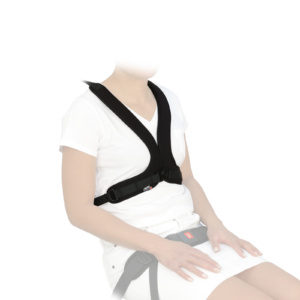Wheelchair users often require postural support devices (PSD’s) such as chest straps/harnesses to reinforce support and optimise function within the wheelchair seating system. This allows support in both the sagittal and coronal planes for stability of the wheelchair user in the wheelchair.
Anterior trunk support may include chest straps and chest harnesses.
- A chest strap is generally only used for balance in the seating system. Individuals with spinal cord injuries may use a chest strap to maintain safety in the wheelchair and this becomes essential to enable independence and function. A chest strap does not impede shoulder mobility but does block anterior trunk movement.
- A chest harness provides a rearward pull to the shoulders to prevent a slumped forward posture but can limit forward reach and blocks anterior trunk movement.
Anterior trunk supports help maintain the seated position and promote trunk stability for function. Postural support devices can potentially be considered constraints; however, their role is complex, and it helps to reflect on the definition described by Babinec et al. (2015)
their role is complex, and it helps to reflect on the definition described by Babinec et al. (2015)
“1. “Supports” are used to achieve a very specific position or posture of a body part in addition to minimizing migration in a specific direction.
2. “Restraints” typically refer to devices that are used to limit harmful motion during vehicular transportation, or a device that is carefully controlled in many settings.”
Utilising tilt within the wheelchair can utilise the force of gravity for increasing stability within the chair, but a tilted seated position is not always practical for function or safe when operating a powered wheelchair, scanning the environment, eating, or socialising.
It might be helpful to consider the following, although these do need to be carefully considered when deciding between chest straps and harnesses:
| Benefits | Risks |
|---|---|
| Can support the trunk to allow for a better stability to allow for improved head and neck position | Used without fully optimising the seating system for stability (seat cushion, backrest, headrest, armrest, lateral trunk supports, footrests) |
| Allow wheelchair users with reduced trunk control or an inability to correct trunk position to participate in activities that challenge their base of support and postural stability (e.g. using a wheelchair outdoors or using arms within activities). | Can cause pressure to the tissue if significant force is placed against the strap/harness for prolonged periods and material does not aid pressure distribution. |
| Allow stability of the upper body in an upright position during wheelchair mobility. | Can further hinder weakened respiratory muscles and adversely affect breathing if incorrectly positioned or utilised. |
| Allows reinforced support to the trunk to facilitate easier movement of the arms without compromising movement at the shoulders. | The wheelchair user may slide down the seat and through the thoracic harness without pelvis being appropriately stabilised on the cushion. |
| Maintain safety of the wheelchair user during mobility. | Placement causes discomfort or pressure on, for example, percutaneous endoscopic gastronomy site. |
When considering an chest strap or harness it is vital to consider pressure distribution, the activity it is required for, and to monitor the impact a chest strap/harness may have on respiratory function for individuals with weakened muscles (Muscular Dystrophy Campaign, 2011; Massery, 2010). It is also important to consider how the harness is fastened and released; it should not hinder transfers or caregiver dependent interventions whilst in the wheelchair.
Use of these devices must be based on assessment, clinical need and grounded in a functional context. Anterior trunk support devices can optimise wheelchair user safety, stability and may be essential to allow for function and engagement in selected activities for improved quality of life.
- Babinec, M., Cole, E., Crane, B., Dahling, S., Freney, D., Jungbluth-Jermyn, B., Lange, M. L., Pau-Lee, Y.-Y., Olson, D. N., Pedersen, J., Potter, C., Savage, D., & Shea, M. (2015). The Rehabilitation Engineering and Assistive Technology Society of North America (RESNA) Position on the Application of Wheelchairs, Seating Systems, and Secondary Supports for Positioning Versus Restraint. Assistive Technology, 27(4), 263–271. https://doi.org/10.1080/10400435.2015.1113802
- Lange, M., & Minkel, J. (2018). Seating and Wheeled Mobility: A Clinical Resource Guide. Slack Incorporated.
- Massery, M. (2010). Breathing and Upright Posture: Simultaneous Needs. 26th International Seating Symposium Syllabus, 25–28.
- Pope, P. (2007). Severe and Complex Neurological Disability. Elsevier. https://doi.org/10.1016/B978-0-7506-8825-3.X5001-5
- Wheelchair Provision for Children and Adults with Muscular Dystrophy and other Neuromuscular Conditions: Best Practice Guidelines. (2011). Muscular Dystrophy Campaign. https://www.musculardystrophyuk.org/news/news/second-edition-wheelchair-guidelines-published/#





